History
Batavia, Illinois was first settled in the 1830s. In 1834, Henry Lyon and Allison Speer were the first two Methodists to move to the village. A third Methodist, William VanNortwick, arrived a year later and allowed church services to be held in his house. As Batavia grew, the size of the congregation became too large to hold in a single house, and plans were made to construct a church building. The First Methodist Church of Batavia was constructed in 1852 for $6,000. [2]
In 1854, Reverend E. H. Gammon was named the first minister. Gammon later accumulated much wealth in agricultural machinery and offered funds for the construction of a newer church. Upon the completion of the new United Methodist Church of Batavia, the original church building was sold to the Batavia Community School District. The old building was re-purposed as the McWayne School Annex and it was used as a school. In 1978, the school district opened two new schools and intended to destroy the McWayne School Annex. The plans were cancelled that year when it was purchased by the Buttrey-Wulff-Mamminga Agency, Inc. It was added to the National Register of Historic Places on March 19, 1982. [2]
The Greek Revival structure was built of locally quarried limestone. The building retains its original wood gable, but it has been covered with asphalt for economic reasons. The bell tower was removed when it was converted into a school. Doric pediments adorn the north and south ends of the building. The interior features eight wooden columns. [2]
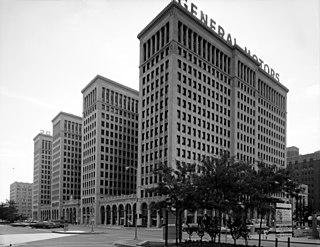
Cadillac Place, formerly the General Motors Building, is a landmark high-rise office complex located at 3044 West Grand Boulevard, in the New Center area alongside the Detroit River, of downtown Detroit, Michigan, in the Great Lakes region of the Midwestern United States.
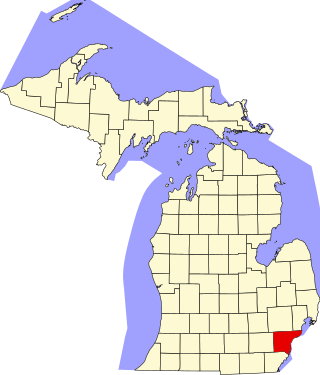
This is a list of the National Register of Historic Places listings in Wayne County, Michigan.

The Sycamore Historic District is a meandering area encompassing 99 acres (400,000 m2) of the land in and around the downtown of the DeKalb County, Illinois county seat, Sycamore. The area includes historic buildings and a number of historical and Victorian homes. Some significant structures are among those located within the Historic District including the DeKalb County Courthouse and the Sycamore Public Library. The district has been listed on the National Register of Historic Places since May 2, 1978.

As of 2007 there are five church buildings in the Sycamore Historic District, located in Sycamore, Illinois, United States which are listed as contributing properties to the district. The Sycamore Historic District was added to the U.S. National Register of Historic Places on May 2, 1978. When it was nominated to join the National Register there were seven church buildings within the district. One of those included is a residential structure that was utilized as a church when it was first constructed; the Arthur Stark House was once home to the Sycamore Universalist Church congregation. In the time since its listing, two churches have been destroyed or demolished. The Evangelical Lutheran Church of St. John was destroyed by fire in 2004 and the United Methodist Church in Sycamore is no longer extant, replaced by a modern office building.

The Batavia Institute also known as Bellevue Place Sanitarium is a Registered Historic Place in Batavia, Illinois, US.
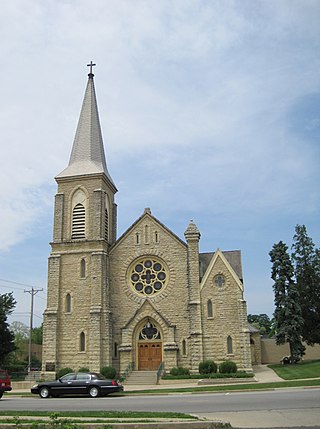
The Eastside Community Center, formerly the Catholic Holy Cross Church, is an historic building in Batavia, Illinois. It was built in 1897 to serve the Holy Cross congregation of Batavia, many of whom were Irish immigrants who came to work in local quarries. The building operated as a church until the 1990s, when the property was transferred to the Batavia Park District. It was added to the National Register of Historic Places in 1999.
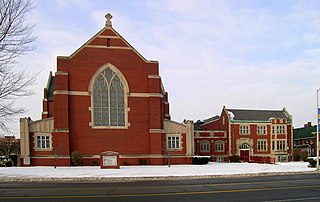
The St. John's Christian Methodist Episcopal Church is a church located in Detroit, Michigan. It was built as the North Woodward Congregational Church, listed on the National Register of Historic Places in 1982, and designated a Michigan State Historic Site in 1998.

Washington Park Historic District, also known as Washington Square is a historic district in and around Washington Park in the city of Ottawa, Illinois, United States. Washington Park was the site of the first Lincoln-Douglas debates of 1858 and is surrounded by several historic structures. The park was platted in 1831 and the historic district was added to the United States National Register of Historic Places in 1973.

The New Mt. Moriah Baptist Church is located at 13100 Woodward Avenue in Highland Park, Michigan in Metro Detroit. It was built in 1922 as the Trinity United Methodist Church, in the Gothic Revival style. It was listed on the National Register of Historic Places in 1982.

This is a list of the National Register of Historic Places listings in Detroit, Michigan.

St. John's United Methodist Church is located in central Davenport, Iowa, United States. It was listed on the National Register of Historic Places in 1983.

The Two Brothers Roundhouse, formerly the Walter Payton Roundhouse, America's Historical Roundhouse, and Chicago, Burlington, & Quincy Roundhouse and Locomotive Shop is a historic building converted to a restaurant in Aurora, Illinois. It was originally constructed in 1856 as a roundhouse for the Chicago & Aurora Railroad and served in this capacity until 1974. It was abandoned until 1995, when a group of investors led by Walter Payton purchased it and converted the building to an entertainment complex. Its most recent tenant is Two Brothers Brewing. The building is the oldest limestone roundhouse in the United States and is listed on the National Register of Historic Places.

The United Methodist Church of Batavia is a historical church in Batavia, Illinois. Funds for the church were donated by Rev. E. H. Gammon and Cpt. Don Carlos Newton in 1887 to replace the First Methodist Church of Batavia. It was designed by famed local architect Solon Spencer Beman in the Romanesque Revival style. It was added to the National Register of Historic Places in 1983.

The Dundee Township Historic District is a set of sixty-five buildings in Dundee Township, Kane County Illinois. Buildings in the district are found in East Dundee, West Dundee, and Carpentersville. The district represents the development of the upper Fox River Valley from 1870 to the 1920s. Dundee Township became an important industrial area, especially following the construction of the Dundee Brick Company in West Dundee and the Illinois Iron and Bolt Company in Carpentersville. Also included in the district are a variety of Queen Anne, Italianate, and Greek Revival style houses and Gothic Revival churches. The majority of the historic district lies within the boundaries of West Dundee. It was added to the National Register of Historic Places in 1975.

Old Hickory Methodist Church is a Methodist congregation which meets at 1216 Hadley Avenue in Old Hickory, Tennessee. The church building was constructed in 1928 and added to the National Register of Historic Places in 1985.
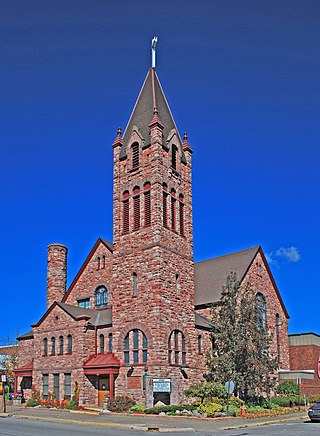
Central Methodist Episcopal Church is a United States historic church at 111 E. Spruce Street in Sault Ste. Marie, Michigan. It was listed on the National Register of Historic Places in 1984 and designated a Michigan State Historic Site in 1993.

The Chelsea Commercial Historic District is a historic district located along both sides of Main Street from Orchard to North Street in Chelsea, Michigan; the district also includes the adjacent 100 blocks of Jackson, East Middle, and West Middle Streets, as well as structures on Park, East, and Orchard Streets. It was listed on the National Register of Historic Places in 2011.

The First United Methodist Church is a Methodist church that was founded in 1868 in Reno, Nevada. In 1868 the first meetings were held in the local schoolhouse on the corner of what is now First and Sierra Streets. In 1871 The first church was erected and dedicated on Sierra Street between First and Second Streets. In the early 1900s the wood-framed church was moved to the back of the lot and a new brick building was added to it. And finally in 1925 plans for a new building were made. Designed by Wythe, Blaken, and Olson of Oakland, the church is one of the first poured concrete buildings in Reno and utilizes Gothic Revival architectural themes. The corner stone for the current historical building was placed in 1926, with the building being dedicated in December of that same year. It was listed on the National Register of Historic Places in 1983; the listing included two contributing buildings. The second building is a parish house designed by local architect Donald Parsons and built in c.1940. In 1965 another addition was done to add on what is currently the fellowship hall, and Sunday school class rooms.

The Asbury Historic District is a 288-acre (117 ha) historic district encompassing the community of Asbury in Franklin Township of Warren County, New Jersey. It is bounded by County Route 632, County Route 643, Maple Avenue, Kitchen Road, and School Street and extends along the Musconetcong River into Bethlehem Township of Hunterdon County. It was listed on the National Register of Historic Places on March 19, 1993 for its significance in architecture, industry, religion, community development, politics/government, and commerce. The district includes 141 contributing buildings, a contributing structure, two contributing sites, and four contributing objects.





















